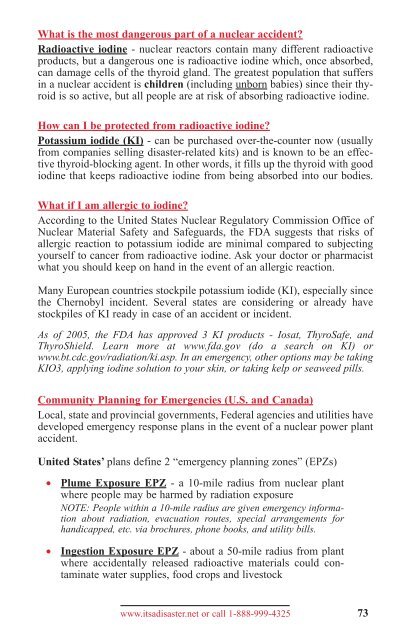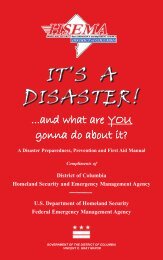disaster 5th 1108_5th ed 2011 - Homeland Security and Emergency ...
disaster 5th 1108_5th ed 2011 - Homeland Security and Emergency ...
disaster 5th 1108_5th ed 2011 - Homeland Security and Emergency ...
Create successful ePaper yourself
Turn your PDF publications into a flip-book with our unique Google optimized e-Paper software.
What is the most dangerous part of a nuclear accident<br />
Radioactive iodine - nuclear reactors contain many different radioactive<br />
products, but a dangerous one is radioactive iodine which, once absorb<strong>ed</strong>,<br />
can damage cells of the thyroid gl<strong>and</strong>. The greatest population that suffers<br />
in a nuclear accident is children (including unborn babies) since their thyroid<br />
is so active, but all people are at risk of absorbing radioactive iodine.<br />
How can I be protect<strong>ed</strong> from radioactive iodine<br />
Potassium iodide (KI) - can be purchas<strong>ed</strong> over-the-counter now (usually<br />
from companies selling <strong>disaster</strong>-relat<strong>ed</strong> kits) <strong>and</strong> is known to be an effective<br />
thyroid-blocking agent. In other words, it fills up the thyroid with good<br />
iodine that keeps radioactive iodine from being absorb<strong>ed</strong> into our bodies.<br />
What if I am allergic to iodine<br />
According to the Unit<strong>ed</strong> States Nuclear Regulatory Commission Office of<br />
Nuclear Material Safety <strong>and</strong> Safeguards, the FDA suggests that risks of<br />
allergic reaction to potassium iodide are minimal compar<strong>ed</strong> to subjecting<br />
yourself to cancer from radioactive iodine. Ask your doctor or pharmacist<br />
what you should keep on h<strong>and</strong> in the event of an allergic reaction.<br />
Many European countries stockpile potassium iodide (KI), especially since<br />
the Chernobyl incident. Several states are considering or already have<br />
stockpiles of KI ready in case of an accident or incident.<br />
As of 2005, the FDA has approv<strong>ed</strong> 3 KI products - Iosat, ThyroSafe, <strong>and</strong><br />
ThyroShield. Learn more at www.fda.gov (do a search on KI) or<br />
www.bt.cdc.gov/radiation/ki.asp. In an emergency, other options may be taking<br />
KIO3, applying iodine solution to your skin, or taking kelp or seawe<strong>ed</strong> pills.<br />
Community Planning for Emergencies (U.S. <strong>and</strong> Canada)<br />
Local, state <strong>and</strong> provincial governments, F<strong>ed</strong>eral agencies <strong>and</strong> utilities have<br />
develop<strong>ed</strong> emergency response plans in the event of a nuclear power plant<br />
accident.<br />
Unit<strong>ed</strong> States’ plans define 2 “emergency planning zones” (EPZs)<br />
• Plume Exposure EPZ - a 10-mile radius from nuclear plant<br />
where people may be harm<strong>ed</strong> by radiation exposure<br />
NOTE: People within a 10-mile radius are given emergency information<br />
about radiation, evacuation routes, special arrangements for<br />
h<strong>and</strong>icapp<strong>ed</strong>, etc. via brochures, phone books, <strong>and</strong> utility bills.<br />
• Ingestion Exposure EPZ - about a 50-mile radius from plant<br />
where accidentally releas<strong>ed</strong> radioactive materials could contaminate<br />
water supplies, food crops <strong>and</strong> livestock<br />
www.itsa<strong>disaster</strong>.net or call 1-888-999-4325<br />
73





